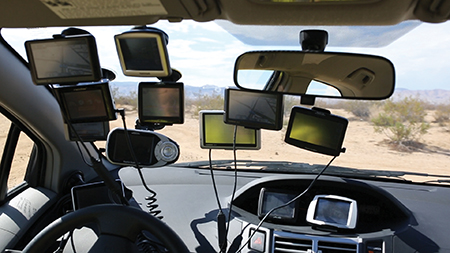Via Frieze
-----
Fourteen30 Contemporary, Portland

In his video California Bloodlines (GPS Dozen) (all works 2013), California artist Jesse Sugarmann drives through a bright desert expanse in search of somewhere elusive. The camera is trained on the car’s dashboard and windshield, which are festooned with 12 GPS devices that relegate the dramatic landscape of sand and scrub, distant mountains and azure sky to a removed presence. As he drives, a chorus of robotic voices talk over one another, blurting out contradictory directions (‘Turn left!’, ‘Turn right!’, ‘Re-calculating!’). Sugarmann’s intended destination is California City, from which the artist’s exhibition at Fourteen30 Contemporary took its name: a place real enough to have assigned geo-positioning coordinates, yet not real enough for the dozen devices to reach consensus.
Geographically, California City is the third-largest city in the Golden State. Its 40- square-mile grid in the Mojave Desert was developed in the 1960s in tandem with the California Aqueduct, which would transform the arid terrain into a lush, cosmopolitan oasis, a two-hour drive north of Los Angeles. But when the aqueduct was rerouted to the west, development was abandoned. In the ensuing half-century, a population of 15,000 made California City home, leaving the unfinished infrastructure of sidewalks and roads to be slowly reclaimed by the desert. Today, the outskirts of this unrealized city play host to Air Force weapons testing and off-road motor sports.
Symbolically, the site evidences a kind of regional amnesia, in which the glitz and glamour of Southern California’s main cultural centre allows this also-ran destination to fade from collective memory. But Sugarmann leverages its metaphoric impact for more personal ends, using California City as a stage to contemplate his mother’s worsening Alzheimer’s. This place, which bears the fundamental shape of a city but conspicuously lacks the city itself, becomes an analogue for his mother’s frustrated attempts to recall and organize a past she knows exists, but can’t seem to access.
In a second video, California Bloodlines (Parts 1 and 2), the artist has arrived in California City, or at least one of its desolate cul-de-sacs. Joined by an assistant, Sugarmann performs a series of actions addressing the site’s past, present and the irreconcilable divide between them. Initially, they appear as stewards, attempting to restore the road to working condition. They patch a makeshift bonfire pit left by an off-road after-party, sweep sand off the weather-beaten pavement (as desert winds violently undo their efforts), and spread a new layer of asphalt. But with the appearance of a sand dragster, a vehicle equally at home on sand or tarmac, the site’s present-day activities creep in, creating a confused connection to its past: the duo spreads asphalt on the exterior of the dragster and sets it ablaze.
In California Bloodlines (Parts 1 and 2), Sugarmann interpolates scenes of his own ‘weapons testing’ in California City, drawing square-mile development tracts onto Perspex in liquid napalm and burning them into the surface. These works were displayed in the gallery like production stills or outtakes from the film, each image executed in thick black burn marks and feathery yellow flickers. It’s not hard to connect the geometric patterns of the tract with the mapping of the human brain in neuro-imaging techniques.
Sugarmann’s previous body of work focused almost exclusively on cars – as figurative bodies, ‘vehicles’ for projecting human desire and as ubiquitous monuments to the fact of obsolescence and mortality. With the California City videos, this connection between subjects and their automotive stand-ins is made more powerful by the artist’s equation of the landscape with memory. Here, the internal stage of mental function – or in the case of his mother, dysfunction – is depicted in physical, spatial terms. And, tragically, in the enacted folly of restoring unused roads, he illustrates how that which is forgotten can never be recovered.
John Motley

